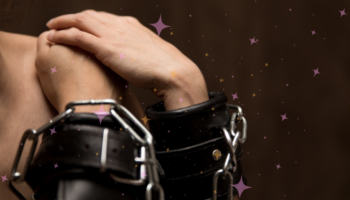Standing by as a curious onlooker, or if you are new to the BDSM scene, you might be wondering why people are into bondage. The ties involved range from simple to elaborate, from a wrist tie to a body harness and more. What's the allure? What's in it for the people involved? Much of what we see when it comes to bondage, especially when it’s as an observer versus a participant, revolves around the visible aesthetics and the perception of what it might feel like to be physically restrained. Yet, that outwardly visual image belies the deeper connection formed between the one doing the tying, and the one being tied. It's not always about dominance. It's not always about sexual gratification. And, while some readers might be familiar with bondage as an act of intimacy, for others, the emotional aspect of rope-work might come as a surprise.
My partner Lily and I have been engaged in bondage play for about two years now. To be honest, it's been very much a learning experience for both of us. When the subject was broached over an IM conversation online, there was a good deal of apprehension involved. My main fear was that such a deep-seated personal act might evoke a sense of dread or fear from the girl I was opening up to.
The Stigma Involved With Bondage
There is still a definite stigma attached to any sort of “deviant” sensual practice, regardless of whether or not the act is actually deviant. Images of power play, rough sex, dominance (or even enslavement) often pop to the forefront. It is an indication of miseducation and misrepresentation linked to how we are socialized to think about intimacy and sensual acts.
And notice that in the last paragraph I used the word "sensual" twice as opposed to SEXUAL. There is a difference. Sensual play evokes emotions and plays with how the senses might be enthralled and eventually released. It does not rely on sex, although sexuality and sexual energy does indeed come into play. Rather than devolve the act of bondage play to an aspect of sex, sensual acts rely on the broader world of emotion and, above all, trust.
Make no mistake - those first few, awkward moments when we unfurled a length of rope and set to work were a mess of butchered knots, miscommunication, and laughter when we were done. We were friends playing with something new, and poking fun at our relative inexperience and mistakes. As with everything, the bondage itself wasn’t awkward in and of itself. It was us testing our own limits, establishing (or breaking down) boundaries, and learning from one another for next time. There were plenty of next times involved. Two years later and we have it down to a science more than an art, but in the process the sensual aspects have evolved into something far greater than simply tying each other up. We have found ways to channel ourselves into both giving and receiving, and have developed a deeper bond than I think either of us might have known.
Why Bondage?
While our story may or may not be a common thread among bondage partnerships, it still begs the question as to why we do this. What do we feel when we are engaged in rope-play? Why does it form such a powerful bond in our friendship and beyond? Why do we use rope when we could share any number of other hobbies that we have in common?
Lily and I both function as “switches” in this relationship. Both of us have experienced tying as well as being tied. We offer you one possible answer: symbolism. Bondage can symbolize placing physical trust in a partner. It is endemic to the entire practice, and frequently cited as a major aspect of why partners incorporate it into their sensual acts.
With a simple wrist tie or blindfold bringing physical form to the bond of trust, it can also bring physicality to internal feelings of struggle; and that, in turn, provides catharsis. By overlaying the stress of daily life, the frustration of rejection, or the battle against life’s little roadblocks onto the physical act of struggling or feeling restricted, it adds a tangible element to intangible emotions. It pulls abstract ideas into the physical world, and offers at least one method by which the struggle can become a real thing that we can overcome.
Using Physical Bondage to Overcome Emotional Bondage
When I'm feeling that I'm struggling at work, or frustrated by administrative delays, being tied can help me release that pent-up frustration. It gives me something to fight against, something physical I can do. It turns the abstract into something that can be challenged, fought against, and struggled with. I can even see if I can release the ties, and if I release the ties, it feels like I can overcome the more abstract ties. That is to say, it feels like I can overcome the feelings I've been struggling with.
In our case, the element of releasing one’s own bonds plays a huge role. Every time I tie Lily, I ask her if she wants to “try to get out.” Most of the time she is more than willing to give it a go. Some partnerships may not include this aspect in their play, but that all comes down to personal choice. Only you and your partner can determine if this should be part of your play. However, with regards to us, the aspect of struggle has become a major part of the entire experience, with Lily trying her best to release the ropes, even if her inhibitions come into play during the act. I applaud her efforts every time, because the act of bondage carries incredible weight for her. She overlays more of her own frustrations on to it than I do. The sense of relief she gets when she slips a knot or unravels a wrist tie is visible; it is cathartic for her. That notion of relief is what has allowed the act to transform from an aspect of play into something far deeper and more gratifying.
When Lily ties me, she says it's a bit different; instead of focusing on her own internal feelings, she's focusing on providing a good experience. She's focusing on the knots, on making sure I'm comfortable while still restricted. I'm testing the knots as she's tying them, making sure they're OK for me. She's checking in with me, making sure everything is OK, and she touches me, making sure I know that she's there. She never does something to me that she is not willing to try herself. That being said, when she ties me, she becomes more confident and even I can feel it. That's a big part of it for her. She is trying to relay that confidence and trust into the rope or in her touch. I can feel her confidence and experience it through my own senses. Being trusted is a loaded emotion, and I want to return it to the best of my ability. The rope serves as a conduit through which these senses and emotions can travel.
Bondage play is a loaded experience. When I was still a teenager, all I saw then was the sexual release and the physical act of exerting power. As I grew, I shared this part of me with others. I learned there was far more involved than just sexual gratification. Far from it because Lily and I frequently abstain from sexual acts during play. Rather, we have come to embrace the trust, embrace the rope, embrace the sensation, and achieve a far deeper relationship than I think either of us would have expected. The rope was just the conduit that got us here. We trust each other more, we provide each other with release and relief, and impart confidence when we are engaged in such practices. It’s not a sexual thing, its a sensual thing.
It’s love, not lust. And it just took 25 feet of rope to attain it. (Read another writer's story in Bondage with Benefits: What I Learned from BDSM.)





